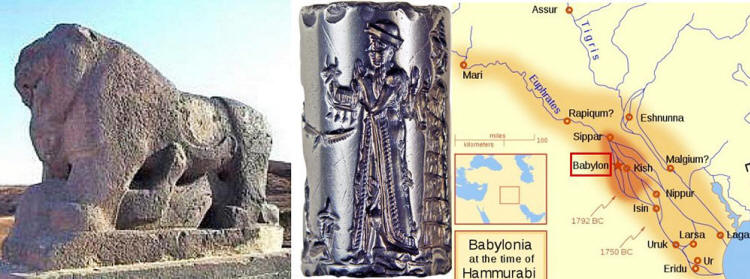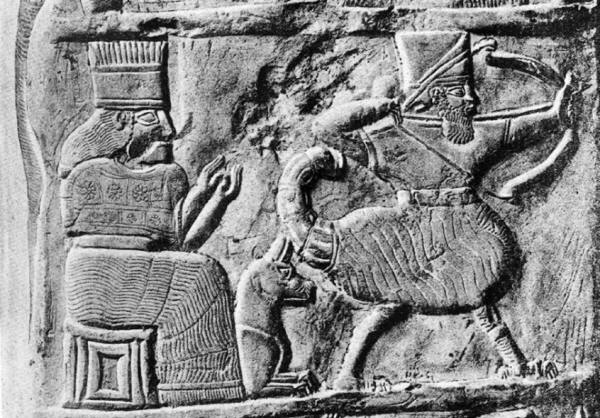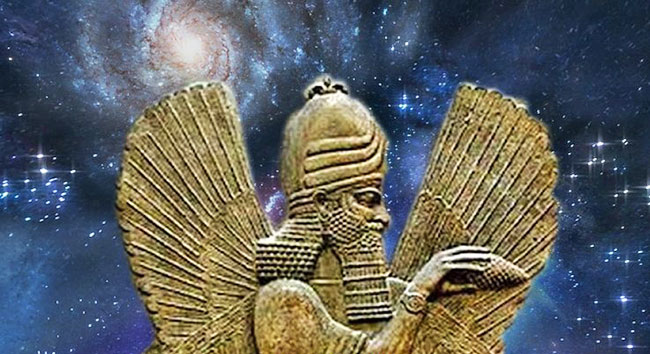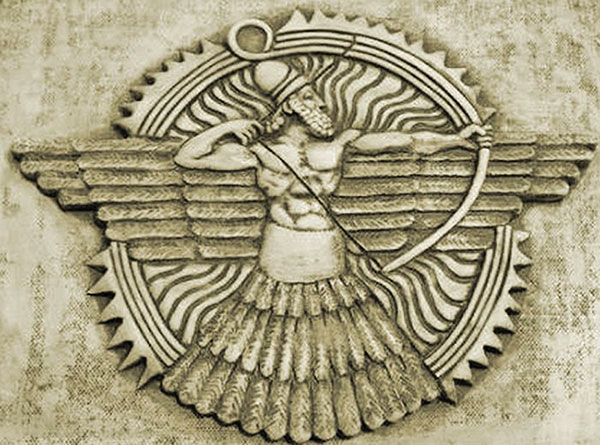|

by Ellen Lloyd
July 04, 2019
from
AncientPages Website

Babylon was the "sacred city"
dedicated to the cult of Marduk,
who had there his temple and a golden statue.
As son of mighty god Enki, creator and protector of humanity,
Marduk plays an important role in Mesopotamian mythology and
history of Babylon.
Babylon was the "sacred city" dedicated to the cult of Marduk, who
there his temple there and a golden statue. In ancient times,
Babylon was considered almost the "center of the world".
Even, Alexander the
Great was charmed by its beauty and power.
From an ancient Assyrian text known as the "Marduk
Prophecy", also referred to as the "Sulgi Prophecies",
one can learn about Marduk's journeys to the lands of the Hittites,
Assyrians, and Elamites and,
'the prediction of a
future king who will lead Marduk back from Elam, an ancient
country in southwestern Iran'...
According to historians,
the Marduk Prophecy was written sometime between 713-612 B.C.
The ancient document was
unearthed in the
House of the Exorcist close to
a temple in the city of Ashur, the first capital of the Assyrian
Empire.
Since this document was most likely written during the reign of King
Nebuchadnezzar I, most historians suggest it served as a
propaganda piece to celebrate his victory.
The Marduk prophecy
describes,
the return of a
strong and powerful king who will restore peace and order to the
city by bringing home the statue of the god.

Detail from kudurru of Nebuchadnezzar
granting itti-Marduk freedom from taxation.
Credit:
Public Domain
King Nebuchadnezzar I,
"marched into Elam
and repatriated the stolen statue of Marduk". 1
The Babylonian King List
informs he ruled for 22 years, and one kudurru reveals King
Nebuchadnezzar I retrieved the statue of god Marduk during his
battle against the Elamites. 2
Babylonians had the so-called 'kudurrus',
stone steles that were sculpted and carved with inscriptions.
They were important not
only for economic and religious reasons but also as almost the only
works of art, which survived from the period of Kassite rule in
Babylonia (c.16th-c.12th century BC).
Many significant
historical events were inscribed on these kudurrus.
Although most think the Marduk Prophecy was written as tribute to
King Nebuchadnezzar I, it's also possible the document served
another purpose.

Interestingly, while excavating in the House of the Exorcist,
archaeologists found several cuneiform tablets that also relates
other events.
"Apart from the 'Marduk
Prophecy,' the inventory includes no text relevant to
Nebuchadnezzar's Elamite campaign which is likely to have been
the primary concern of the author of our text, but there are
some texts proclaiming the superiority of the Assyrian chief
deity Assur over Marduk (e.g. the 'Marduk
Ordeal').
This suggests that
the owner of the Assur exemplar had far more interest in
theological reflection on the relationship between the Assyrian
and the Babylonian state gods, which was presumably stimulated
by the Assyrian abduction of the Marduk statue under Sennacherib
(689 B.C.), than in the triumph of Nebuchadnezzar." 1
This has led some to
speculate whether the Marduk Prophecy was perhaps written in
connection as to how Marduk should be evaluated in relation to
the god Assur, the most important deity of the Assyrian capital
Ashur.

Ashur, the chief god
of the Assyrian pantheon in Mesopotamian religion,
worshipped mainly in the northern half of Mesopotamia,
and parts of north-east Syria and south-east Asia Minor (old
Assyria).
The prophecy also
contains astrological omen texts and mentions certain ancient
places associated with specific constellations.
Many predictions in the Marduk and Sulgi prophecies, as well as
in the Uruk Prophecy, likewise have exact parallel in the
astrological corpus." 3
Since Babylonians and
Sumerians had advanced knowledge of astronomy, it's not surprising
to discover they relied on celestial objects for a number of
reasons, and there are specific parallels between prophecy
predictions, astrological omens and astronomical
events...
References
-
Takuma Sugie -
The Reception of the Marduk Prophecy
in Seventh-Century B.C. Assur - Orient. 2014,
Vol.49, No.0, p.107.
-
Benjamin R.
Foster -
Before the Muses: An Anthology of
Akkadian Literature
-
Biggs, Robert D.
- "The
Babylonian Prophecies and the Astrological Traditions of
Mesopotamia" - Journal of Cuneiform Studies37,
no. 1 (1985): 86-90. doi:10.2307/1359960.
|





